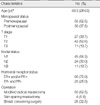Abstract
Purpose
Recent randomized phase III trial by the Breast Cancer International Research Group (BCIRG 001) showed that docetaxel plus doxorubicin and cyclophosphamide (TAC) is superior to fluorouracil plus doxorubicin and cyclophosphamide (FAC) as adjuvant chemotherapy for node-positive operable breast cancer. Unfortunately, TAC was clearly more toxic than FAC not only with respect to neutropenic fever events, but also with respect to many extrahematological side effects. The aim of this study was to evaluate the toxicity and tolerability of Korean patients with breast cancer treated with TAC.
Methods
This study was conducted on 80 patients with breast cancer who underwent primary surgery at the Department of Surgery in Soonchunhyang University (4 affiliated hospitals) from October 2005 to October 2008. The patients received 480 courses consisting of TAC (75/50/500 mg/m2, every 3 weeks for 6 cycles) without prophylactic granulocyte colony-stimulating factor (G-CSF). Toxicity was graded according to the National Cancer Institute Common Toxicity Criteria version 3.0.
Results
The main toxicities were hematologic (neutropenia grade 3/4 in 98.8% of patients and 92.3% of cycles; febrile neutropenia in 42.5% of patients and 16.0% of cycles). No cases of septic death occurred. The peak time of occurrence for febrile neutropenia was 7-10 days after receiving chemotherapy (mean duration, 2.05 days). Severe nonhematologic adverse events were as follows: myalgia (30.0%), neurotoxicity (17.5%), fatigue (16.3%), stomatitis (12.5%), and nausea (11.3%).
Conclusion
An adjuvant TAC regimen without prophylactic G-CSF was tolerable in Korean patients with breast cancer. Although most of the patients developed neutropenia, the nonhematologic toxicities (cardiac toxicity) were tolerable. Further studies on prophylactic G-CSF use to assess the contribution to reduced hematologic toxicities are required in Korean patients with breast cancer.
Figures and Tables
 | Figure 1Time of occurrence of grade 3/4 neutropenia and febrile neutropenia. (A) The peak time of occurrence of grade 3/4 neutropenia was 6-8 days after receiving chemotherapy. (B) The peak time of occurrence of febrile neutropenia was 7-10 days after receiving chemotherapy. |
References
1. Bonadonna G, Brusamolino E, Valagussa P, Rossi A, Brugnatelli L, Brambilla C, et al. Combination chemotherapy as an adjuvant treatment in operable breast cancer. N Engl J Med. 1976. 294:405–410.

2. Fisher B, Brown AM, Dimitrov NV, Poisson R, Redmond C, Margolese RG, et al. Two months of doxorubicin-cyclophosphamide with and without interval reinduction therapy compared with 6 months of cyclophosphamide, methotrexate, and fluorouracil in positive-node breast cancer patients with tamoxifen-nonresponsive tumors: results from the National Surgical Adjuvant Breast and Bowel Project B-15. J Clin Oncol. 1990. 8:1483–1496.

3. Levine MN, Bramwell VH, Pritchard KI, Norris BD, Shepherd LE, Abu-Zahra H, et al. National Cancer Institute of Canada Clinical Trials Group. Randomized trial of intensive cyclophosphamide, epirubicin, and fluorouracil chemotherapy compared with cyclophosphamide, methotrexate, and fluorouracil in premenopausal women with node-positive breast cancer. J Clin Oncol. 1998. 16:2651–2658.

4. Levine MN, Pritchard KI, Bramwell VH, Shepherd LE, Tu D, Paul N, et al. Randomized trial comparing cyclophosphamide, epirubicin, and fluorouracil with cyclophosphamide, methotrexate, and fluorouracil in premenopausal women with node-positive breast cancer: update of National Cancer Institute of Canada Clinical Trials Group Trial MA5. J Clin Oncol. 2005. 23:5166–5170.

5. Henderson IC, Berry DA, Demetri GD, Cirrincione CT, Goldstein LJ, Martino S, et al. Improved outcomes from adding sequential Paclitaxel but not from escalating Doxorubicin dose in an adjuvant chemotherapy regimen for patients with node-positive primary breast cancer. J Clin Oncol. 2003. 21:976–983.

6. Mamounas EP, Bryant J, Lembersky B, Fehrenbacher L, Sedlacek SM, Fisher B, et al. Paclitaxel after doxorubicin plus cyclophosphamide as adjuvant chemotherapy for node-positive breast cancer: results from NSABP B-28. J Clin Oncol. 2005. 23:3686–3696.

7. Martin M, Pienkowski T, Mackey J, Pawlicki M, Guastalla JP, Weaver C, et al. Adjuvant docetaxel for node-positive breast cancer. N Engl J Med. 2005. 352:2302–2313.

8. The Korean Breast Cancer Society. Nationwide Korean breast cancer data of 2004 using breast cancer registration program. J Breast Cancer. 2006. 9:151–161.
9. Singletary SE, Allred C, Ashley P, Bassett LW, Berry D, Bland KI, et al. Staging system for breast cancer: revisions for the 6th edition of the AJCC Cancer Staging Manual. Surg Clin North Am. 2003. 83:803–819.

10. Nabholtz JM, Mackey JR, Smylie M, Paterson A, Noël DR, Al-Tweigeri T, et al. Phase II study of docetaxel, doxorubicin, and cyclophosphamide as first-line chemotherapy for metastatic breast cancer. J Clin Oncol. 2001. 19:314–321.

11. Boér K, Láng I, Juhos E, Pintér T, Szántó J. Adjuvant therapy of breast cancer with docetaxel-containing combination (TAC). Pathol Oncol Res. 2003. 9:166–169.

12. Demetri GD, Zenzie BW, Rheinwald JG, Griffin JD. Expression of colony-stimulating factor genes by normal human mesothelial cells and human malignant mesothelioma cells lines in vitro. Blood. 1989. 74:940–946.

13. Zsebo KM, Yuschenkoff VN, Schiffer S, Chang D, McCall E, Dinarello CA, et al. Vascular endothelial cells and granulopoiesis: interleukin-1 stimulates release of G-CSF and GM-CSF. Blood. 1988. 71:99–103.

14. Souza LM, Boone TC, Gabrilove J, Lai PH, Zsebo KM, Murdock DC, et al. Recombinant human granulocyte colony-stimulating factor: effects on normal and leukemic myeloid cells. Science. 1986. 232:61–65.

15. Kitagawa S, Yuo A, Souza LM, Saito M, Miura Y, Takaku F. Recombinant human granulocyte colony-stimulating factor enhances superoxide release in human granulocytes stimulated by the chemotactic peptide. Biochem Biophys Res Commun. 1987. 144:1143–1146.

16. Yuo A, Kitagawa S, Ohsaka A, Saito M, Takaku F. Stimulation and priming of human neutrophils by granulocyte colony-stimulating factor and granulocyte-macrophage colony-stimulating factor: qualitative and quantitative differences. Biochem Biophys Res Commun. 1990. 171:491–497.

17. Platzer E, Welte K, Gabrilove JL, Lu L, Harris P, Mertelsmann R, et al. Biological activities of a human pluripotent hemopoietic colony stimulating factor on normal and leukemic cells. J Exp Med. 1985. 162:1788–1801.

18. Martín M, Lluch A, Seguí MA, Ruiz A, Ramos M, Adrover E, et al. Toxicity and health-related quality of life in breast cancer patients receiving adjuvant docetaxel, doxorubicin, cyclophosphamide (TAC) or 5-fluorouracil, doxorubicin and cyclophosphamide (FAC): impact of adding primary prophylactic granulocyte-colony stimulating factor to the TAC regimen. Ann Oncol. 2006. 17:1205–1212.





 PDF
PDF Citation
Citation Print
Print






 XML Download
XML Download